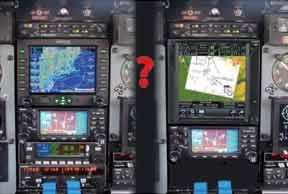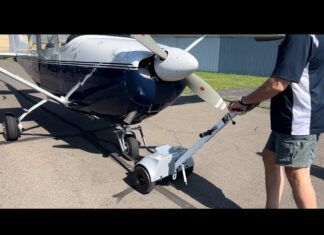Remember overlaying your ADF needle on an Argus moving map display? This is what started the ball rolling on dedicated MFD displays. Years later, Avidyne revolutionized the big MFD with the original FlightMax series. But the upgrade demand for standalone MFDs has plummeted to near extinction. The first salvo was Garmins 530, whose screen took the GPS navigator to the near-MFD level. The new GTN 750 now crosses the line with every major MFD feature save ships radar. On the other end of the scale, most MFD map functions are mimicked by aeras, iPads and the like-and for far less cash. If your goal includes displaying radar, or demands a panel-mounted display without an accompanying navcomm upgrade, there are numerous products to choose from. Shopping the used market could offer cheaper alternatives. 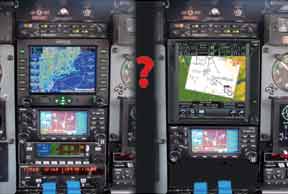
Garmin: MFD and MFD Killer
Garmin still offers the GMX200 MFD in its lineup, but with the GTN750 on its heels we have to wonder for how long. Weve covered the GTN750 (and smaller 650) extensively over the past few months, so here we’ll look at its MFD functions. Just remember this is all on top of it being a full WAAS GPS/nav/com.
In Garmin tradition, the GTN750 is built around a liberal remote sensor interface with a generous availability of data input formats and ports, from RS232 to digital Arinc, and GAMA to Ethernet.
You wont have to place your peepers on the units display for long to realize its up to the dedicated MFD challenge. It sports a near-VGA-quality display and touchscreen controls. That display is a high-resolution mega-color TFT LCD with a 600 x 708 pixel count. Overall, the unit stands tall in the radio stack at six inches vertical, but compared to separate MFD and navigator, its a huge space (and dollar) saver.
The GTN750 comes standard with a wealth of functions that were once optional on retrofit MFDs: Garmin FliteCharts, SafeTaxi, terrain and obstacles, airways and graphical flight planning. Traffic alerting, XM weather and sferics display cost extra but are available. Want to lose the audio panel and transponder from the radio stack? The GTN750 can channel these units remotely.
The GMX200 is a worthy MFD that shares little in common with the GTN750. It originally started life as the MX20 from the old UPS-AT days. Still, most agree that it offers an easy feature set and speedy processor that makes for quick map redraws and efficient weather graphic refreshes. It also has a split-screen mode and impressive terrain functions, including a look-ahead or vertical profile view of obstacles.
Speaking of vertical profile, the I/O version of the GMX200 overlays the Bendix/King RDR2000/2001, RS181-series radar plus Garmins own GWX68 radar. The GMX200 doesnt come with charts. you’ll need to buy a Jeppesen subscription and $2395 Chartview unlock for that. VFR and IFR en route charting is standard, however.
The GMX200 is a space-eater, requiring five inches of vertical space for its crisp and bright 6.5-inch diagonal LCD display. As with any stand-alone MFD, you’ll need a GPS to drive it and the GMX200 plays with most. A top of the line GMX200 I/O Radar unit retails for $17,390 with Chartview option or $13,390 with just traffic capability and charts.
Avidynes EX-Series
Avidyne replaced the popular and worthy EX500 (a good used buy for the right price as we’ll explain later) with the EX600. The newer MFD is big but not huge. It stands 4.93 inches high and fits the standard 6.24-inch rack-width. Weighing 4.75 pounds and fairly deep at 11 inches, the box feels substantial and sturdy.
There’s a lot of display area at 5.8 inches diagonal, and Avidyne stepped up the panning capability for that big display-something the EX500 lacked. With the EX600, you can finally pan the map to look at weather or other features that lurk miles away.
The newer transflective screen technology has many benefits including good visibility in low and high light environments, but can appear dim when wearing sunglasses. Further, this display appeared dimmer than some other displays that were collocated in the radio stacks of a small twin, even though its designed for better sunlight readability. Some owners are pleased with the EX600 in their stacks. Others struggle while using certain sunglasses.
The EX600 and EX500 require 28-volts bus input. A 14-volt system requires a voltage converter. These beefy power supplies are hungry and weve seen more than one stress a marginal charging system. A power supply also means there is another remote box to install, with the associated hassle and expense.
Satellite Weather is supplied by the MLB700, a SIRIUS-based satellite receiver with products provided by WSI InFlight (a HeadsUp XMD76 series, XM-based system will work also). For active lightning data, the TXW670 or L-3 WX500 will easily input, as will nearly every common traffic system including the Avidyne TAS600.
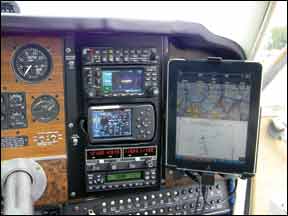
The cMax approach charts capability (Jeppesen-charts) are standard on all EX600s and the base unit starts at $9990. Common radar interfaces like a RDR160 bump that price to $13,990 and big-airplane radar interfaces can bump that price to nearly $17,000. Replacing an EX500 with the EX600 is a reasonably easy project as long as there’s spare space to work with.
Honeywell Bendix/King
Two MFDs remain in the Bendix/
King line: the KMD150 and KMD250. The lower-end KMD 150 is available either with or without a built-in GPS receiver. The system can function as a standalone VFR GPS navigator, or driven by an existing KLN 89B, KLN 90B or KLN 94 GPS. It also has steering outputs for coupling to an autopilot. The KMD150 map dates back to the SkyForce days, which is obvious when comparing what you get on the five-inch diagonal display to other modern screens.
But its easy to use with an intuitive joystick control. The KMD150 with internal GPS is $4168 and non-GPS flavor is $3871.
The KMD250 is a holdover from the pricey IHAS line. It accepts a variety of remote inputs including the $7000 Bendix/King KDR-series XM Weather system, WX500 Stormscope, and TAWS/traffic sensors. The KMD250 has a sharp 3.8-inch-diagonal ACML display-small but crisp enough for utilitarian mapping. The bezel stands three inches high, making it ideal for replacing an old Loran. It has an integral non-WAAS GPS. At nearly $6000, though, its pricey for dated technology.
Were not sure of the longevity of these products, frankly, as it took us a while to confirm if they were readily available or not.
PFD/MFD glass panels
We extensively covered the G500 and EFD1000-series displays in the May 2011 issue of Aviation Consumer. These represent far bigger install jobs and prices-think $15,000 to $30,000 once all the bills are paid-as they are an upgrade to a full glass panel, but you do gain MFD functionality.
In summary, Garmins G500/600 has a split-screen bezel with a dedicated MFD on the right. Aspen does a similar duty but with two separate displays, which provides redundant backup and flight data integrity cross-checking with dual-AHRS. There’s also split-screen data capability. Take a look at the May issue for more details.
On the MFD side, G500 has FliteCharts (NACO approach charts) and SafeTaxi standard. The pricey Jeppesen ChartView is optional. Aspen offers NACO charts only, but they are georeferenced (your position is shown on the chart) where FliteCharts are not. An annual Flite-Chart subscription for the Garmin is $395. For the Aspen, its $299, and is supplied by Seattle Avionics. Garmins G500 has an option for displaying some ship radars.
We think the Aspen MFD500 would be an excellent standalone MFD for space challenged panels. All bets are off, however, as it relies on an accompanying 1000PFD to feed it heading data. For this reason, it can only function as a secondary or third add-on display to a primary PFD.
Used Market Deals
When shopping the used MFD market, you’ll need to keep a sharp eye on unit flavor, particularly if overlaying radar is a requirement. Avidyne told us they can easily modify a non-radar capable EX500 but for a hefty cost. Understand, too, that EX500s that arent equipped for cMax charts require a $2000-plus add-on. Unless the unit is still under warranty (Avidyne offers an extended warranty plan), any repairs will be flat-rated.
In scanning the used MFD market, we found some good deals. One reputable reseller had an EX500 advertised for $2900. It didnt have charts, but at that price we think its a steal. Avoid old MX20s like the plague. One display failure and its a paperweight. (A GMX200 can replace an MX20 with minimal fuss.) GMX200s demand premium pricing, but a good eye can score one with charts for around $5000. If you have to play traffic on a GMX200, be sure to buy the GMX200 I/O-Traffic flavor. The base GMX200 wont do it.
Before making a used purchase, get a quote for installation. You don’t want surprises when you show up with box in hand. MFD installations arent complicated. In fact, wiring is reasonably straightforward. Its the panel work to make them fit that runs up the bill. The best case is mounting the display in the main avionics stack for optimal viewing.
This space dilemma is resolved with all-in-one navigators that serve double-duty as MFDs.
Roll your own MFD
If the main driver on your MFD decision is budget, there are seemingly countless ways to build your own multi-data displays. First is panel-mounting a portable GPS with the popular AirGizmos docking station. Maybe its an older GPS496 or newer touchscreen aera; these units mounted in the panel offer a cost-effective way of decluttering a loose portable strung across the cabin while offer-ing the convenient visibility of a panel-mount.
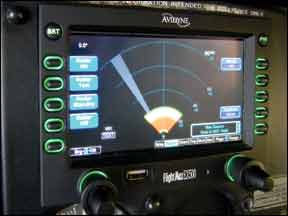
Installing an AirGizmos in a certificated aircraft panel used to be an unethical and taboo practice. Now its commonplace. The arguing shops wore their FSDOs down and many now view the install as a minor alteration sealed with an appropriate logbook entry. Obtain counsel from your shop, however, before taking the plunge.
The Gizmo dock is a sturdy polycarbonate plastic housing with feed-through channels for routing interface cables to the connector ports on the portable. No stray wires involved. The housing secures to existing radio rails or other appropriate structure. This isn’t a slap-and-go affair; your shop still needs to wire power and ground to a circuit breaker and route antenna cables. If the interface includes a data connection to a panel-mount GPS for flight plan overlay, thats more wiring and teardown yet. But its still far less money than any panel-mount MFD. For example, the Gizmo dock for a Garmin 496 or aera runs about $100. You can also get an angle adapter for canting the unit for better visibility.
The iPad has become a permanent fixture in many cockpits, encouraged further by Aspens recent announcement of their under-$2500 Connected Cockpit interface. The connection allows wireless loading of flight plan and other data between the iPad and Aspen MFD and then to a remote GPS. A behind-the-panel interface module that has Bluetooth, USB and Wi-Fi is the com hub for the interface. At Oshkosh, Aspen demonstrated loading frequencies and flight plans from an iPad running ForeFlight into a developmental Honeywell KSN 770. While this might smell more like gimmick than real-world usefulness, other manufacturers including JP Instruments, PS Engineering and Sportys are jumping on the interface. We think it represents a bold and fresh way of thinking that promises to simplify the approach to panel integration.
But mounting the sizeable iPad in the panel poses some challenges, although were told AirGizmos is working on an iPad dock. you’ll need to get creative by using a cradle and RAM surface or yoke mount. Heat and vibration can be an issue. But the capability is impressive. We think the most MFD-like app would be WingX running on an iPad2. This offers full moving map with split screen, geo-referenced charts. Add subscription-free ADS-B weather with an $1100 SkyRadar box. XM weather is available, too. WingX also does synthetic vision via a separate ADHS. Foreflight is a bit less feature-rich an app, but we think easier to use if your main desire is airport data, moving map and charts.
Securing a modern portable to or in the panel isn’t trivial, but when you can walk away with MFD capability starting at about $1000 installed, its worth real consideration.
Conclusion
Take to heart this real-world tale of woe. We know a buyer who thinks his newly installed EX600 is a decent unit, but buyers remorse is deep because he seldom uses it. His RAM-mounted iPad is where his fingers and eyes are the most. The EX600 is up for sale and thoughts have turned toward a GTN 750 to replace both it and his GNS 530.
If both an MFD and GPS navigator upgrade are calling your wallet, we think an all-in-one Garmin GTN750 fits the bill. It wont play radar, but itll do most everything else. For a similar cost, you could also look at an Aspens PFD/MFD1000 combination and get your MFD as part of a glass panel upgrade with high-level redundancy. If you just want a big-and-bright moving map, we don’t see how you can beat a panel-mount portable or an iPad.
For the narrow-need niche thats left, wed probably go used and try to get the niche filled as cost-effectively as possible.

